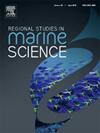海南岛红树林生态系统总初级生产力时空动态及环境驱动因素
IF 2.4
4区 环境科学与生态学
Q3 ECOLOGY
引用次数: 0
摘要
红树林生态系统对蓝色碳固存(海洋和沿海生态系统捕获和储存的碳)至关重要,其总初级生产力(GPP)是其碳捕获潜力的关键指标。然而,估算红树林生态系统的区域尺度GPP及其对环境因子的响应仍然具有挑战性。本研究以海南岛红树林生态系统为研究对象,利用高分辨率Sentinel-2卫星图像,计算了海南岛红树林生态系统吸收光合有效辐射(fAPAR)的组分。我们将机器学习技术与红树林植被光合作用光利用效率(MVP-LUE)模型相结合,回顾性地估计了过去20年的历史fAPAR和GPP。利用偏微分归因方法对环境驱动因子进行了量化分析。我们的发现可以概括为三点。首先,优化后的集合模型对红树林生态系统fAPAR具有较高的估计精度(R2 = 0.77, RMSE = 0.08)。(2)海南岛红树林生态系统年GPP总体呈上升趋势,年增长率为3.46 gC m−2 y−2;GPP峰值出现在旱季向雨季过渡期间(213.73 gC m−2 mo−1),最小值出现在旱季中期(76.07 gC m−2 mo−1)。从空间上看,东部和北部地区GPP较高。红树林生态系统GPP的变化主要受fAPAR的驱动。对红树林GPP的环境影响的量化提高了我们对这些高产生态系统内碳循环动态的理解,为保护和恢复工作提供了信息。本文章由计算机程序翻译,如有差异,请以英文原文为准。
Spatiotemporal dynamics and environmental drivers of gross primary productivity in mangrove ecosystems of Hainan Island
Mangrove ecosystems are crucial for blue carbon sequestration (carbon captured and stored by oceans and coastal ecosystems), with gross primary productivity (GPP) acting as a key indicator of their carbon capture potential. However, estimating regional-scale GPP for mangrove ecosystems and their response to environmental factors remains challenging. In this study, we focused on the mangrove ecosystems of Hainan Island, utilizing high-resolution Sentinel-2 imagery to derive the fraction of absorbed photosynthetically active radiation (fAPAR). We combined machine learning techniques with the mangrove vegetation photosynthesis light use efficiency (MVP-LUE) model to retrospectively estimate historical fAPAR and project GPP over two decades. Spatiotemporal distribution patterns were analyzed, and environmental driving factors were quantified using partial differential attribution. Our findings can be summarized in three major points. First, the optimized ensemble model demonstrated high accuracy in estimating mangrove ecosystem fAPAR (R2 = 0.77, RMSE = 0.08). Second, the mangrove ecosystems of Hainan Island exhibited an overall increasing trend in annual GPP at a rate of 3.46 gC m−2 y−2 over the study period. Peak GPP occurred during the transition from dry to rainy season (213.73 gC m−2 mo−1), with minimum GPP in the mid-dry season (76.07 gC m−2 mo−1). Spatially, GPP was higher in the eastern and northern regions. Finally, changes in the GPP of mangrove ecosystems were primarily driven by fAPAR. The quantification of environmental effects on mangrove GPP enhances our understanding of carbon cycling dynamics within these highly productive ecosystems, informing protection and restoration efforts.
求助全文
通过发布文献求助,成功后即可免费获取论文全文。
去求助
来源期刊

Regional Studies in Marine Science
Agricultural and Biological Sciences-Ecology, Evolution, Behavior and Systematics
CiteScore
3.90
自引率
4.80%
发文量
336
审稿时长
69 days
期刊介绍:
REGIONAL STUDIES IN MARINE SCIENCE will publish scientifically sound papers on regional aspects of maritime and marine resources in estuaries, coastal zones, continental shelf, the seas and oceans.
 求助内容:
求助内容: 应助结果提醒方式:
应助结果提醒方式:


